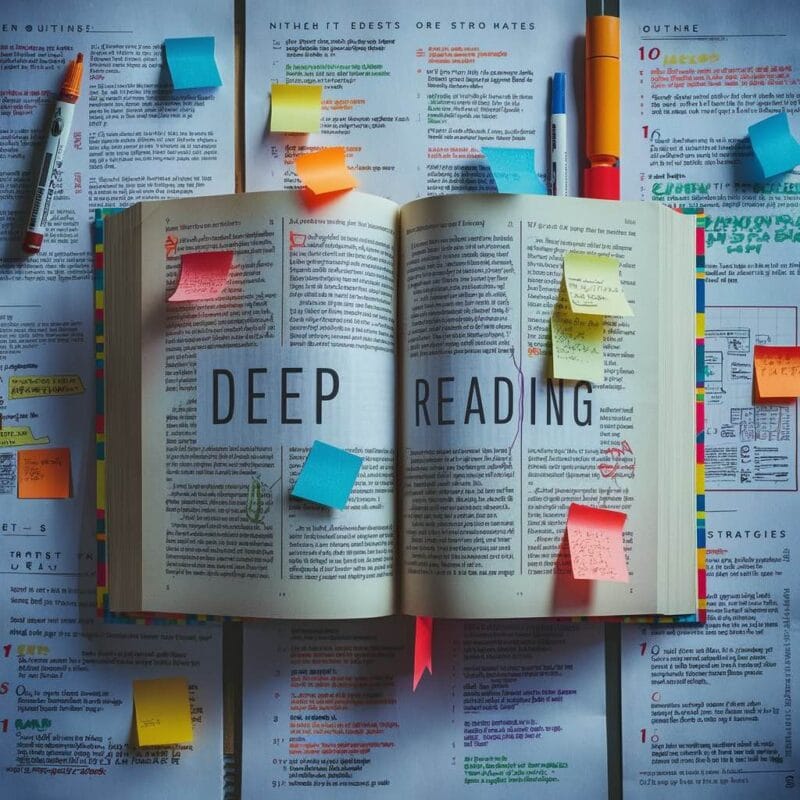- Reading extensively is crucial for writers aiming to enhance their craft. Immersing in high-quality literature helps writers understand diverse styles, vocabulary, and narrative structures, which are essential for storytelling.
- Reading and writing are interconnected, fostering communication skills and intellectual growth.
- Foundational skills in vocabulary, grammar, and sentence structure are critical. Reading diverse texts helps writers develop unique voices and understand effective writing techniques, grammar, and syntax. Exposure to various ideas also fuels creativity.
- Effective reading strategies and consistent routines are vital for writing skills development. Aspiring writers should employ:
– Daily Reading Practice: Dedicate time each day to read a variety of genres and styles to broaden understanding.
– Active Reading Techniques: Annotate texts, highlight key phrases, and take notes on effective writing techniques observed.
– Writing Prompts: Use insights from readings as prompts for writing exercises.
– Literary Analysis: Analyze texts for structure, character development, and thematic elements.
– Vocabulary Building: Compile a list of new words from readings and incorporate them into your writing.
– Author Emulation: Experiment by mimicking the styles of admired authors to develop versatility in writing techniques. - Creating a daily routine for reading and writing maximizes skill retention. Keeping a journal to reflect on readings correlates material with writing tasks, reinforcing learning.
Many writers struggle with improving their writing skills, often overlooking the significant impact that reading can have on their craft. The concept of “read to write,” or reading extensively to enhance an author’s understanding of diverse writing styles, vocabulary, and narrative structures, can provide them with the tools needed for effective storytelling. By immersing themselves in high-quality literature, writers can observe and absorb techniques that improve their own writing.
Programs like “Read to Write” emphasize the importance of reading as a foundation for writing education, helping teachers integrate high-quality literature into their curriculum. These initiatives not only cover the statutory requirements for writing but also enrich students’ learning experiences through exposure to poems and expanded vocabulary.
Aspiring authors can develop strong reading habits to gain insights into creative writing strategies, word choice techniques, and control over syntax. Whether one is an educator or a budding writer, the act of reading is a powerful tool that aids in expressing oneself more fluently and effectively in writing.
The Symbiotic Relationship Between Reading and Writing

Reading and writing are deeply interconnected, enhancing and shaping each other through active engagement in both activities. This relationship fosters better communication skills and intellectual growth.
Foundations of Reading and Writing Skills
Students build foundational skills in both reading and writing during their early educational years; awareness, vocabulary, grammar, and sentence structure are critical components.
While strong reading skills enable text comprehension, which supports effective writing; conversely, writing reinforces reading skills by requiring the application of linguistic knowledge.
Furthermore, phonemic awareness is the ability to hear and manipulate sounds in words. It is essential for decoding words while reading and for spelling words while writing.
Vocabulary development is crucial. A broad vocabulary empowers students to understand more complex texts and express ideas more precisely in writing.
How Reading Enhances Writing Ability
Reading exposes students to various writing styles, genres, and structures. This exposure helps writers develop their unique voice and approach to different types of writing.
By reading a diverse range of texts, students learn to recognize effective writing techniques. This recognition includes the use of narrative structures, persuasive tactics, and descriptive language.
Reading also aids in grasping grammar and syntax. Writers observe how sentences are constructed and how ideas are logically presented. This observation improves their ability to craft coherent and compelling texts.
Reading can inspire creativity. Exposure to different ideas and perspectives broadens a writer’s understanding of the world, which can lead to more insightful and innovative writing.
Developing Reading and Writing Skills
Effective teaching strategies and consistent routines play a crucial role in enhancing reading and writing skills. Structured activities and personal habits both contribute to skill development in significant ways.
Instructional Strategies for Skill Improvement
Teachers should employ a range of methods to target specific areas of reading and writing development. Small-group instruction allows for personalized attention and can be effective in addressing individual student needs.
Workshops focusing on tasks like spelling, grammar, and syntax help solidify foundational skills. Reading comprehension exercises can improve understanding and critical thinking, which are essential for effective writing. Techniques such as word chains, in which students break down words into phonemes, seamlessly integrate reading and writing practices.
Developing strong reading habits also enhances vocabulary and exposes students to different writing styles and structures.
Creating a Reading-Writing Routine
Establishing a consistent routine for reading and writing practice maximizes skill retention and growth. Students should be encouraged to set aside time daily for both activities. This can involve reading diverse genres to understand various writing styles and practicing free writing to develop their voice.
Keeping a journal where students reflect on what they read and how it influences their writing can be a powerful tool. It helps to correlate reading material with writing tasks, reinforcing learning. Teachers may also assign projects that require students to read specific texts and then produce written responses, essays, or creative pieces inspired by their readings.
The Role of Reading in Writing Development
Reading plays a pivotal role in enhancing writing skills by expanding vocabulary and aiding the comprehension of grammar and structure. These components are fundamental for effective writing.
Expanding Vocabulary through Reading
Exposure to different texts introduces readers to new words and phrases. By encountering various contexts, they learn the meanings, usages, and nuances of these words.
Reading diverse genres and styles, such as fiction, non-fiction, poetry, and technical writing, broadens a writer’s lexicon. This increased vocabulary allows writers to express ideas more precisely and creatively.
Consistent reading habits also facilitate word retention and recall, which are essential for effective communication in writing.
Understanding Grammar and Structure
Reading aids writers in internalizing grammatical rules and learning how to manipulate language to convey meaning. Observing sentence structure, paragraph organization, and overall composition in various texts provides a practical understanding of writing mechanics.
Different writing styles teach valuable lessons in tone, voice, and pacing. Through reading, writers appreciate the varied ways to construct arguments, narratives, and descriptions, enhancing their ability to craft coherent and engaging pieces.
By incorporating these insights into their own writing, individuals can improve clarity and effectiveness, making their work more compelling and polished.
From Reading to Writing: Bridging the Gap
Reading critically and writing meaningfully are interconnected skills that enhance each other. To bridge the gap from reading to writing, it is crucial to leverage analytical skills gained from reading to inform and refine writing practices.
Analyzing Texts to Inform Writing
When reading a text, one should practice analyzing its structure, language, and themes. This analysis can help understand how the author build narratives, develop characters, and convey messages. For instance, in Lesley Roessing’s book, Bridging the Gap: Reading Critically and Writing Meaningfully to Get to the Core (2014), writing students learn to deconstruct memoirs and other nonfiction pieces.
Taking notes on important passages and author techniques can also help students guide their own writing. They can emulate effective strategies, such as dialogue creation, descriptive language, and narrative pacing. By identifying strengths and weaknesses in professional texts, they are able to cultivate a critical eye that can be applied to their own writing, leading to improved quality and depth.
Applying Reading Comprehension to Writing
Implementing reading comprehension strategies directly into writing exercises can help solidify skills. For example, aspiring writers can use context clues, inferencing, and summarizing while crafting their essays or stories. By applying these techniques, they enhance clarity and coherence in their work.
Moreover, active reading practices such as annotating texts and engaging in discussions about readings can serve as prewriting activities. These methods help students organize their thoughts and generate ideas for their writing tasks. Readers can facilitate this process by creating prompts that require them to reflect on their readings and incorporate those insights into their writing assignments.
In essence, the fusion of reading and writing activities ensures aspiring authors become adept at producing thoughtful, well-structured written pieces.
Writing Techniques Inspired by Reading
By engaging deeply with different texts, writers can absorb and refine various techniques. These techniques include adopting styles and tones, as well as incorporating literary devices.

Adopting Styles and Tones
Reading a variety of authors helps writers recognize different narrative styles and tones. This exposure can be instrumental in shaping their own writing voice. For instance, a writer might notice the concise, impactful style in Hemingway’s works versus the elaborate, lyrical prose of Virginia Woolf.
Writers can experiment by mimicking these styles in their practice. This not only improves their versatility but also helps them understand what styles resonate best with their own voice. Consistent reading and practice can also aid in developing a distinct tone, whether it’s formal, conversational, or poetic.
Another technique is to focus on sentence structure. By comparing different authors’ approaches to sentence length and complexity, writers can adapt these techniques to enhance readability or create a specific mood.
Incorporating Literary Devices
Literary devices such as metaphors, similes, and symbolism can add depth to writing. By studying how seasoned authors use these devices, writers can learn to integrate them more effectively into their own work.
For instance, metaphors can transform mundane descriptions into vivid imagery. Reading how an author seamlessly blends a metaphor into their narrative can inspire a writer to try something similar in their stories.
Dialogues in novels provide another learning opportunity. Analyzing dialogue can help writers develop more authentic and engaging conversations in their own work. They can learn how to balance dialogue and narrative to maintain a natural flow.
Additionally, observing how authors like George Orwell use foreshadowing can teach writers to subtly hint at future events, creating suspense and maintaining reader interest.
Critical Reading for Better Writing
Critical reading enriches writing by sharpening the ability to evaluate sources and reflect on personal growth and development in one’s own writing.
Evaluating Sources and Arguments
Critical reading begins with evaluating the credibility of sources and the robustness of their arguments. This involves identifying the author’s main points and assessing whether the evidence supports these points effectively.
Readers should pay attention to logical fallacies, such as hasty generalizations or false dichotomies. It’s important to differentiate between fact and opinion. Assessing the reliability of sources also includes checks for bias and the relevance of the data provided.
To maintain objectivity, readers must look at multiple perspectives on a subject. Cross–referencing with other texts helps verify information and provides a balanced view. Finally, readers should take notes on compelling arguments and sources to strengthen their own writing.
Reflective Reading for Personal Writing Growth
Reflective reading focuses on how texts impact personal writing styles and skills. Analyzing writing techniques—like how authors develop ideas or create engaging introductions—can offer valuable insights for improvement.
To make reading more effective, readers should highlight key phrases and sentences. Identifying unfamiliar terms and researching them enriches vocabulary and understanding. Reflecting on why certain texts resonate can reveal personal writing preferences and weaknesses.
Engaging in reflective reading involves noting down inspiring elements, such as unique word choices or sentence structures. Incorporating such techniques helps in developing a more versatile writing style. Ultimately, reflective reading is a tool for continuous improvement and adaptation in writing.
Overcoming Challenges in Reading to Write
Reading and writing are intrinsically linked processes, and overcoming obstacles in one can greatly enhance skills in the other.
Addressing Reader’s Block and Writer’s Block
Reader’s block and writer’s block often coexist, hindering productivity and creativity. For novice writers, this can be particularly challenging. To counter this, break tasks into smaller steps. For instance, instead of reading an entire chapter, focus on a single section. This reduces the feeling of being overwhelmed.
Another method is to use timed sessions to create structure. For example, set a timer for 25 minutes of reading, followed by a 5-minute break (the Pomodoro technique). This technique can also apply to writing tasks. Consistent, timed intervals can improve focus and maintain a steady pace.
Lastly, incorporate guided reading sessions, which offer personalized support. These sessions can be tailored to individual needs, enhancing comprehension and reducing frustration. Providing immediate feedback and support can lessen the anxiety associated with reading and writing tasks.
Strategies for Comprehension and Expression
Enhancing comprehension and expression skills is vital. Utilize scaffolded instruction to ensure that you gradually builds up your skills. Start with simpler texts and progressively introduce more complex material. This step-by-step approach helps make challenging texts more approachable.
It is also helpful to make connections between reading and writing. Encourage yourself to apply what your read to your own writing. For example, if you identify sensory details in a narrative, you should use similar details in your own stories. This practice reinforces concepts and aids in retention.
You can also integrate technology and resources. Educational apps, digital platforms, and audiobooks provide interactive and engaging ways to improve comprehension and expression. Tools like text-to-speech can help with both reading and writing, especially for those who struggle with traditional methods.
Lastly, emphasize the importance of understanding language. Addressing any underlying oral language weaknesses can significantly improve reading comprehension, which, in turn, enhances writing abilities.
Resources and Tools for Improved Literacy
To enhance literacy capabilities, both traditional methods and modern technology can provide significant advantages. The following sections discuss vital resources and tools that aid in this process.
Utilizing Technology in Reading and Writing
Technological advancements offer a variety of tools to support reading and writing skills. iWriteWords and Kids Writing Pad are useful apps for young learners to practice handwriting. For older students, Popplet helps with story planning and mind-mapping.
Additionally, platforms like Google Docs facilitate collaborative writing and synchronous editing. Quill.org provides interactive writing prompts and lesson plans, enabling teachers to guide classes effectively. These tools collectively provide structured support, enabling personalized and interactive learning experiences.
Accessing Literacy Support and Communities
Support groups and dedicated communities can significantly enhance literacy. The National Center on Improving Literacy offers expert advice and resources funded by the Office of Elementary and Secondary Education.
Teachers can use Quill Lessons for group instruction, incorporating interactive slides and writing prompts. TeachThought lists various resources aimed at different grade levels, ensuring students receive age-appropriate literacy support. These communities and platforms provide access to specialized guidance and communal learning opportunities.
Further Reading
Joyce Carol Oates on the Importance of Reading for Writers by MasterClass
6 Tips for Reading Like a Writer by Mark Beaver, Writer’s Digest
How Reading Across Genres Improves Your Writing by Anurag, Medium
The Art of Close Reading (Reading Like a Writer) and the Importance of Small Details by Mark Spencer, Plot Summit




